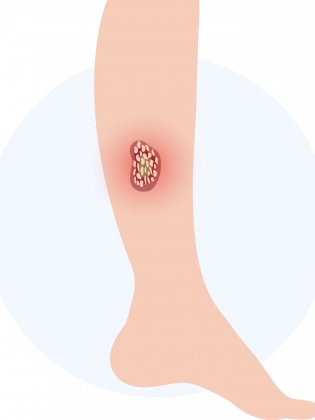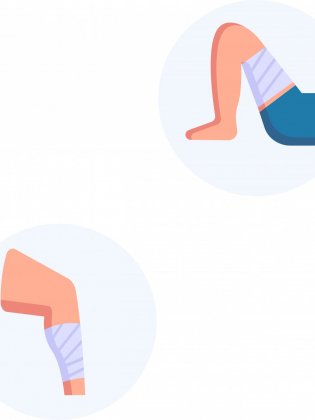Punch Skin Grafting
What is punch skin grafting?
Punch skin grafting is a simple procedure which involves placing sections of thin skin on the surface of an ulcer in order to stimulate epidermalization and allow the wound to heal.
This surgery is performed by your vascular physician and requires outpatient hospitalization. You will return home the same day.

How is the surgery performed at the American Hospital of Paris?
A member of the outpatient nursing team will contact you in the early afternoon the day before your surgery, or on Friday if your surgery is scheduled for Monday. During this call, the nursing team member will confirm your arrival time (depending on the time of the grafting) and the documents that you will need to bring.
On the day of the graft, the outpatient nurse will assess your ulcer and perform the care and cleansing necessary for the graft.
The doctor will perform the graft surgery in your room. You will be in your hospital bed and, after a local anesthetic, the doctor will take the grafts (small pieces of skin) from your thigh and place the small pieces of skin on your ulcer.
The procedure will take between one and a half and two hours.
Following this procedure, the nurse will apply dressings on the thigh where the graft was taken and on your ulcer.
Before you leave, the doctor will give you:
- The order for nursing care for the dressings
- The prescription for medications and products needed for care
- An antibiotic prophylaxis for three days may also be prescribed for you
- If needed, a voucher for transportation to return to your home
- The date of your next appointment
It is important that someone accompany you when you return home by taxi or private vehicle.
The report of the procedure will be available in the patient portal or sent to you by mail
How to prepare for Punch skin grafting?
Before the graft
Jusqu’à la veille de la greffe, votre infirmière réalise les pansements de votre ulcère comme prévu avec votre médecin.
N’oubliez pas de faire vos courses pour les jours suivant la greffe, il vous sera recommandé d’éviter de vous déplacer inutilement et de rester au repos pendant quelques jours.
After the graft
For three days after the graft:
- Rest as much as possible and keep the grafted leg elevated, if possible
- Avoid long walks and unnecessary moving around, even at home
- Do not drive or ride a bicycle
After three days, we recommend that you resume reduced daily physical activity (from 30 minutes to an hour every day).
Avoid taking a shower or bath for seven days after the graft surgery.
After one week, you can take a shower, but avoid getting your dressings wet (you can put your leg in a plastic bag and tape it at the top to prevent water from entering). You should not take a bath while you are wearing dressings.
For one month, wear loose, comfortable shoes, but do not go barefoot.
Also, change your socks every day.
Dressings
As soon as you can start taking showers again, you should shower preferably before the nurse visits
Dressing on the thigh where the graft was taken
The dressing on your thigh must be changed by a nurse at your home 48 hours after the procedure, then every 48 hours until it is completely healed.
Dressing on the grafted ulcer
The dressing on the ulcer must be changed by a nurse at your home three days after the procedure, then every day for the next seven days. After this initial period, the dressing must be changed as specified in the protocol the doctor will give you.
When the dressing is opened, if the grafts are in place, you should not touch them.
If you do not see any grafts, they may be in the dressing. In that case, the nurse will reposition them on the ulcer.
The doctor will assess the ulcer at your next appointment.

Is it possible that the grafts won’t take?
The graft may not take, but this is not serious.
The grafts placed on the wound contain live cells that play an important role for your ulcer. Those cells clean and stimulate the wound to help it heal.
In addition, they release growth factors that are essential in the healing process. These cells also help reduce the pain and, most of the time, reduce the need for pain medication.
Will several grafts be necessary?
Several grafts may be necessary to completely heal the ulcer (repeated grafts).
Your doctor will discuss this possibility with you if the situation arises.
